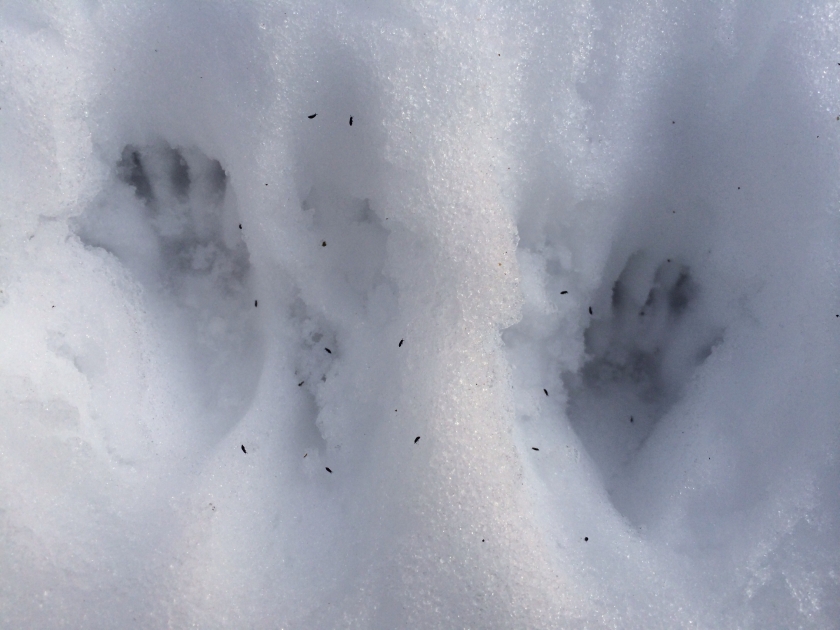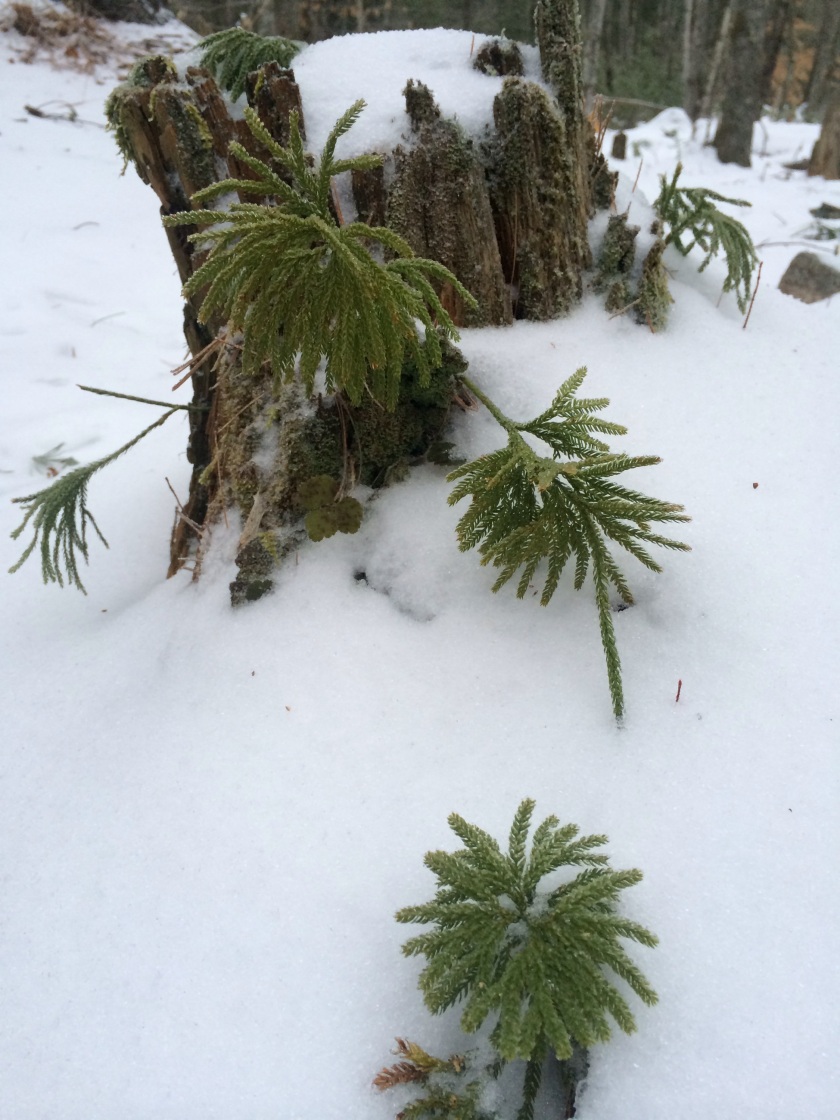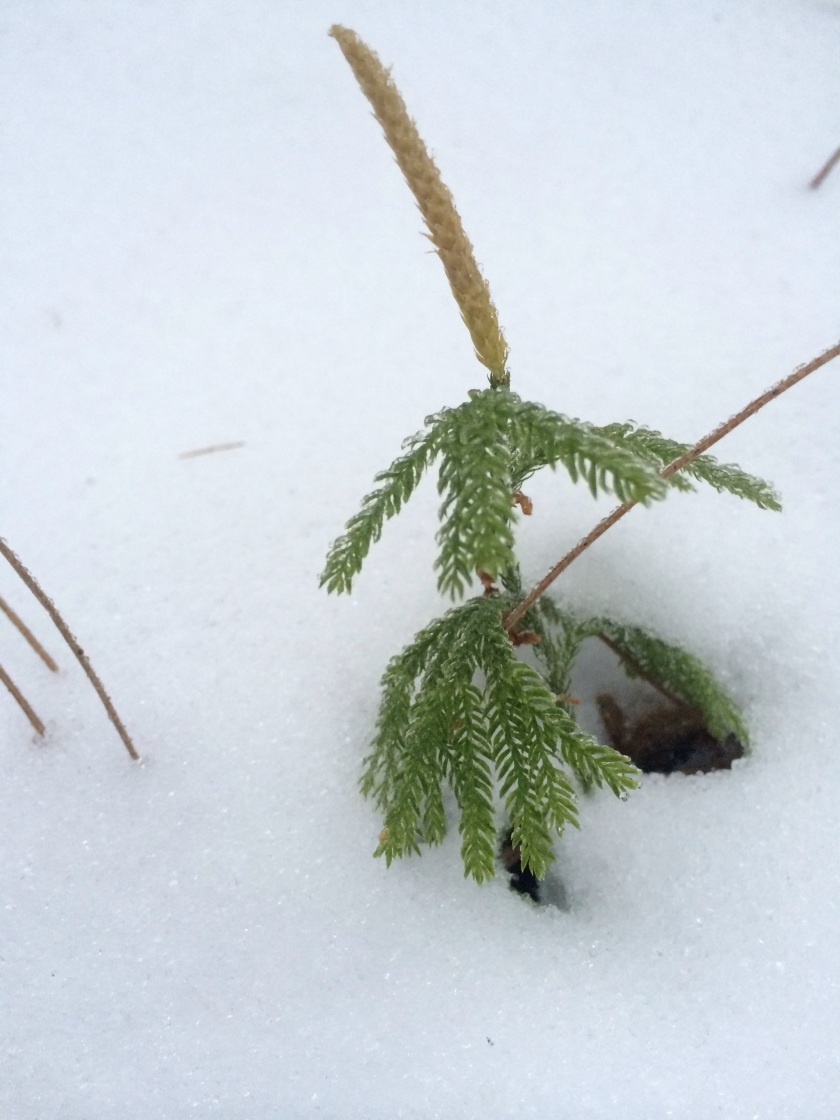The real voyage of discovery consists not in seeking new landscapes, but in having new eyes. Marcel Proust
To clarify, I’m all for seeking new landscapes! Like April in Paris, this spring, where we’ve just booked a hotel a block from Notre Dame! In our everyday world, though, there are plenty of new discoveries to be made, if we would just look for them.

The forest is still criss-crossed with animal tracks. As the snow turned thin and slushy this week, the imprints stood out in greater detail. Tiny “handprints” of red squirrels were everywhere, as were the squirrels themselves. The warmth prompted me to carry along my binoculars and to pause from time to time. The repeated call of a barred owl came from afar, but it was mostly red squirrels that I saw.
One explored an ancient log pile, dark and damp, adorned with scattered piles of demolished pine cones. He moved with fluid energy among the logs, popping out first here, then there, to scold me. Later, another bravely stood his ground atop a stone wall. Only his haunches moved, quivering with indignation, and the shiny blackness of his eye stared me down. He looked fit and well-fed, the subtle gray and rust of his sleek fur elegant in the drab and cloudy light.

Canine tracks still mystify me. The one above was repeated in a single line that roughly followed my old trail for quite a distance. Both coyotes and foxes frequent these woods.

There’s green stuff out there, too. Not just trees, but much more, if you look closely. This small native plant, whose relatives once dominated primeval swamps, is very common. Somehow, it thrives in the northern forest, surviving months of ice and snow.
Looking a bit like a miniature spruce and often called “running pine,” the club moss is neither a conifer nor a moss. Closely related to ferns, the club mosses are vascular plants, with “veins” of xylem and phloem. Their ancestors were once the most complex plants on Earth. In the Carboniferous period, 350 million years ago, club mosses well over 100 feet tall dominated the forest that was later transformed to vast deposits of coal.

This species, Lycopodium clavatum, is found in damp woodlands throughout North America. During the asexual part of its rather complex reproductive cycle, it produces spores, which are released from the plant’s erect, yellow-brown strobilus.
The spores are, for me, perhaps the most fascinating part of the story of the club moss. High in oil content, they are water resistant and flammable. Native tribes knew many medicinal uses for the spores, and, according to the Virginia Native Plant Society, medicine men tossed them on the fire during ceremonies to produce a flash of light.
In my reading, I found a host of other historical uses for the powdery spores, including flash photography, magician’s tricks, fingerprinting powder, fireworks, and treating rashes. Good incentive, perhaps, to try collecting some this year!

Reading this blog was a lovely way to start Friday!
LikeLiked by 1 person
This was very interresting.I see another book in the future. Thank you for sharing all your excitment of your walks.
LikeLiked by 1 person
I’ll be watching for you to add incendiary magic tricks to your repertoire!
LikeLiked by 1 person
What a treasure chest of memories you revived with this blog. Running pine is the catalyst as I could remember gathering it from the Virginia woodlands on my grandparents’ 800 acre farm in its colonial setting. Since my winters have been in an urban setting (northern Jersey) or a more tropical setting (Florida), I enjoyed your pictures of the running pine in the snow as they introduced a new surrounding to me.
Paris on April? That sounds heavenly. Europe was opened up to me in the early 1960’s when I received an award to study French at the University of Poitiers in Tours. Paris was our first stop and then we moved on to soaking up the Loire Valley. May your family’s visit be magnifique.
Loved the quote about seeing places!
Dotty
LikeLiked by 1 person
Hi Dotty! Our trip itinerary does include the Loire Valley, as well as Normandy and Brittany. It will be my first trip to France and indeed magnifique to share the experience with Megan and my parents. Looking forward to writing about all we see!
LikeLike
I am finding these natural things in our woods too, but the woods are also filled with the remains of the big clean up from the October 30th wind and rainstorm. It must have been a microburst that passed through blowing down 80 trees–mostly pines, but some oaks. Fortunately, we are reaching the end of the clean up, but the woods are full of branches and upended butts of the trees.
LikeLiked by 1 person
The clean up sounds like a tough job, but you must have ended up with some good firewood. I’ve seen similar devastation around Sheepscot village. It was quite the storm!
LikeLike